Individual Taxpayer Taxation Law Case Study: LAW 6001
VerifiedAdded on 2022/09/16
|12
|2725
|30
Case Study
AI Summary
This case study analyzes the tax implications for an individual taxpayer named Eric, covering various income sources and deductions. The analysis begins with an introduction to assessable earnings and ordinary income, referencing relevant sections of the ITAA 1997. It then breaks down Eric's income from employment, including gross wages, allowances, and fringe benefits (specifically a car benefit), determining their taxability. The case study explores deductions related to employment, such as work-related expenses. Part B focuses on Eric's business income, including cash receipts, trading stock, and compensation for loss of income, along with related deductions. The impact of cash versus accrual accounting methods is also discussed. Part C examines income from rental property and associated deductions. The case study also addresses dependent tax offsets and concludes by summarizing the key findings, referencing relevant legislation and case law throughout. The solution provided is in accordance with the ITAA 1997 and ITAA 1936.
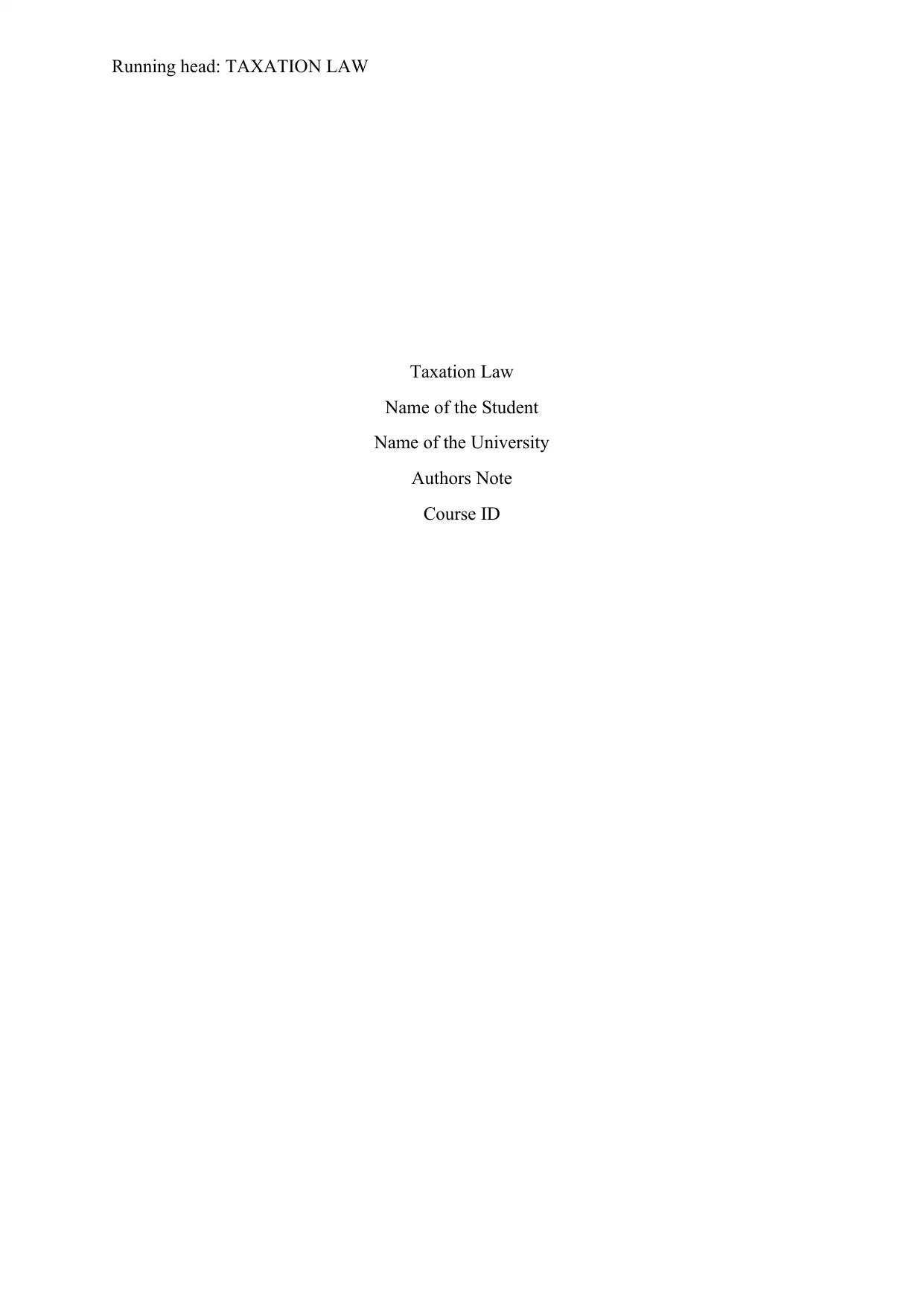
Running head: TAXATION LAW
Taxation Law
Name of the Student
Name of the University
Authors Note
Course ID
Taxation Law
Name of the Student
Name of the University
Authors Note
Course ID
Paraphrase This Document
Need a fresh take? Get an instant paraphrase of this document with our AI Paraphraser
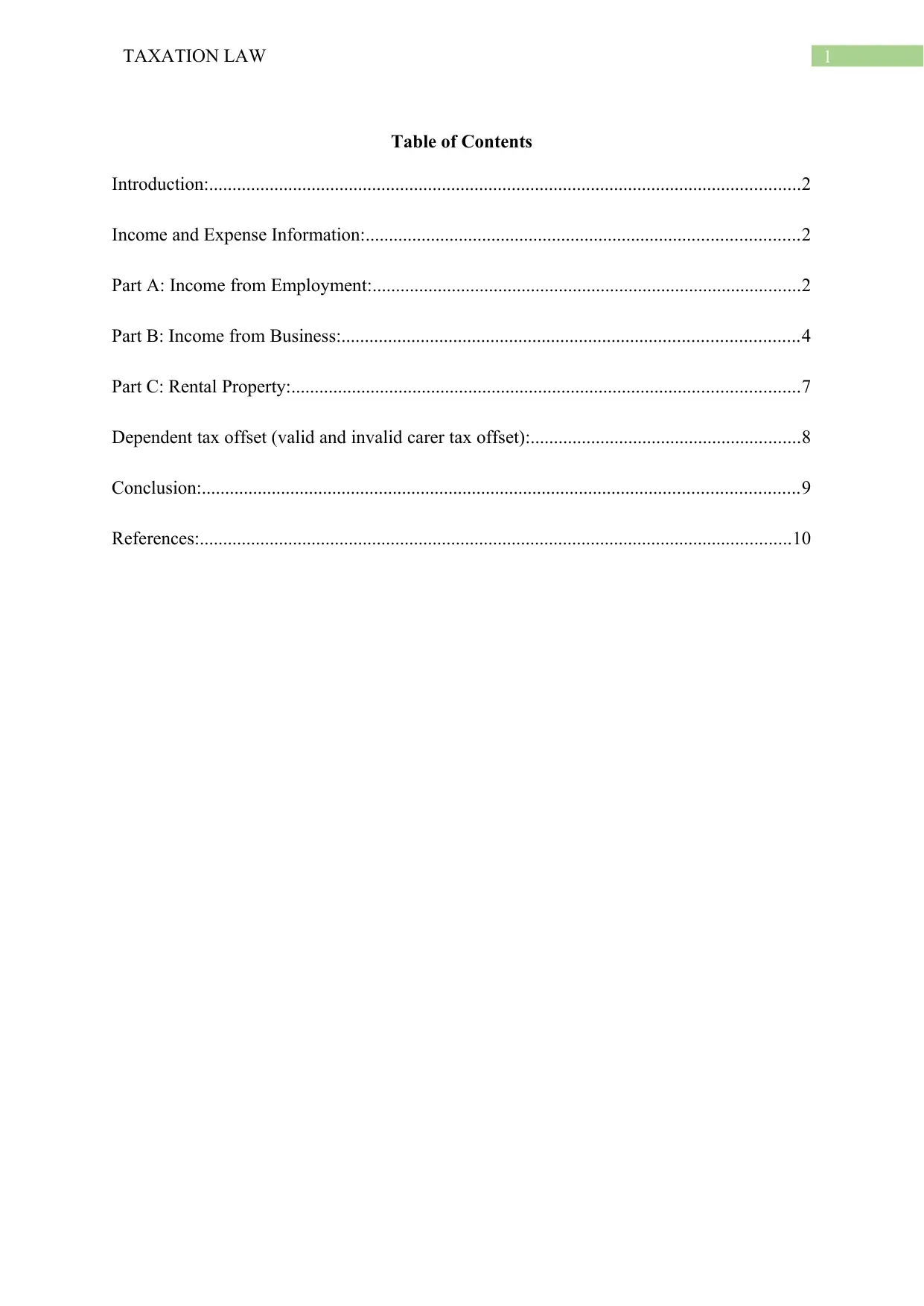
1TAXATION LAW
Table of Contents
Introduction:...............................................................................................................................2
Income and Expense Information:.............................................................................................2
Part A: Income from Employment:............................................................................................2
Part B: Income from Business:..................................................................................................4
Part C: Rental Property:.............................................................................................................7
Dependent tax offset (valid and invalid carer tax offset):..........................................................8
Conclusion:................................................................................................................................9
References:...............................................................................................................................10
Table of Contents
Introduction:...............................................................................................................................2
Income and Expense Information:.............................................................................................2
Part A: Income from Employment:............................................................................................2
Part B: Income from Business:..................................................................................................4
Part C: Rental Property:.............................................................................................................7
Dependent tax offset (valid and invalid carer tax offset):..........................................................8
Conclusion:................................................................................................................................9
References:...............................................................................................................................10
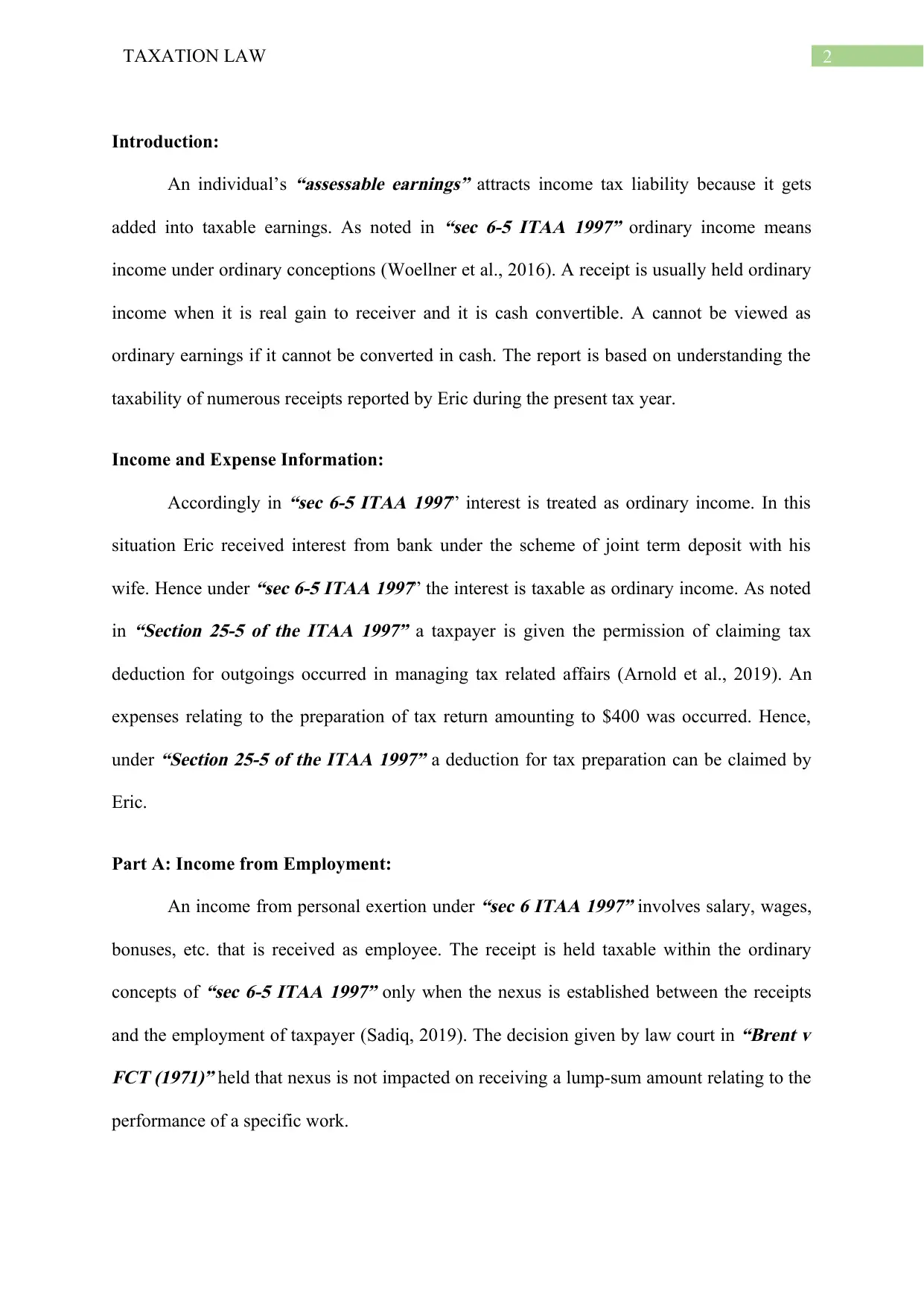
2TAXATION LAW
Introduction:
An individual’s
“assessable earnings” attracts income tax liability because it gets
added into taxable earnings. As noted in
“sec 6-5 ITAA 1997” ordinary income means
income under ordinary conceptions (Woellner et al., 2016). A receipt is usually held ordinary
income when it is real gain to receiver and it is cash convertible. A cannot be viewed as
ordinary earnings if it cannot be converted in cash. The report is based on understanding the
taxability of numerous receipts reported by Eric during the present tax year.
Income and Expense Information:
Accordingly in
“sec 6-5 ITAA 1997” interest is treated as ordinary income. In this
situation Eric received interest from bank under the scheme of joint term deposit with his
wife. Hence under
“sec 6-5 ITAA 1997” the interest is taxable as ordinary income. As noted
in
“Section 25-5 of the ITAA 1997” a taxpayer is given the permission of claiming tax
deduction for outgoings occurred in managing tax related affairs (Arnold et al., 2019). An
expenses relating to the preparation of tax return amounting to $400 was occurred. Hence,
under
“Section 25-5 of the ITAA 1997” a deduction for tax preparation can be claimed by
Eric.
Part A: Income from Employment:
An income from personal exertion under
“sec 6 ITAA 1997” involves salary, wages,
bonuses, etc. that is received as employee. The receipt is held taxable within the ordinary
concepts of
“sec 6-5 ITAA 1997” only when the nexus is established between the receipts
and the employment of taxpayer (Sadiq, 2019). The decision given by law court in
“Brent v
FCT (1971)” held that nexus is not impacted on receiving a lump-sum amount relating to the
performance of a specific work.
Introduction:
An individual’s
“assessable earnings” attracts income tax liability because it gets
added into taxable earnings. As noted in
“sec 6-5 ITAA 1997” ordinary income means
income under ordinary conceptions (Woellner et al., 2016). A receipt is usually held ordinary
income when it is real gain to receiver and it is cash convertible. A cannot be viewed as
ordinary earnings if it cannot be converted in cash. The report is based on understanding the
taxability of numerous receipts reported by Eric during the present tax year.
Income and Expense Information:
Accordingly in
“sec 6-5 ITAA 1997” interest is treated as ordinary income. In this
situation Eric received interest from bank under the scheme of joint term deposit with his
wife. Hence under
“sec 6-5 ITAA 1997” the interest is taxable as ordinary income. As noted
in
“Section 25-5 of the ITAA 1997” a taxpayer is given the permission of claiming tax
deduction for outgoings occurred in managing tax related affairs (Arnold et al., 2019). An
expenses relating to the preparation of tax return amounting to $400 was occurred. Hence,
under
“Section 25-5 of the ITAA 1997” a deduction for tax preparation can be claimed by
Eric.
Part A: Income from Employment:
An income from personal exertion under
“sec 6 ITAA 1997” involves salary, wages,
bonuses, etc. that is received as employee. The receipt is held taxable within the ordinary
concepts of
“sec 6-5 ITAA 1997” only when the nexus is established between the receipts
and the employment of taxpayer (Sadiq, 2019). The decision given by law court in
“Brent v
FCT (1971)” held that nexus is not impacted on receiving a lump-sum amount relating to the
performance of a specific work.
⊘ This is a preview!⊘
Do you want full access?
Subscribe today to unlock all pages.

Trusted by 1+ million students worldwide
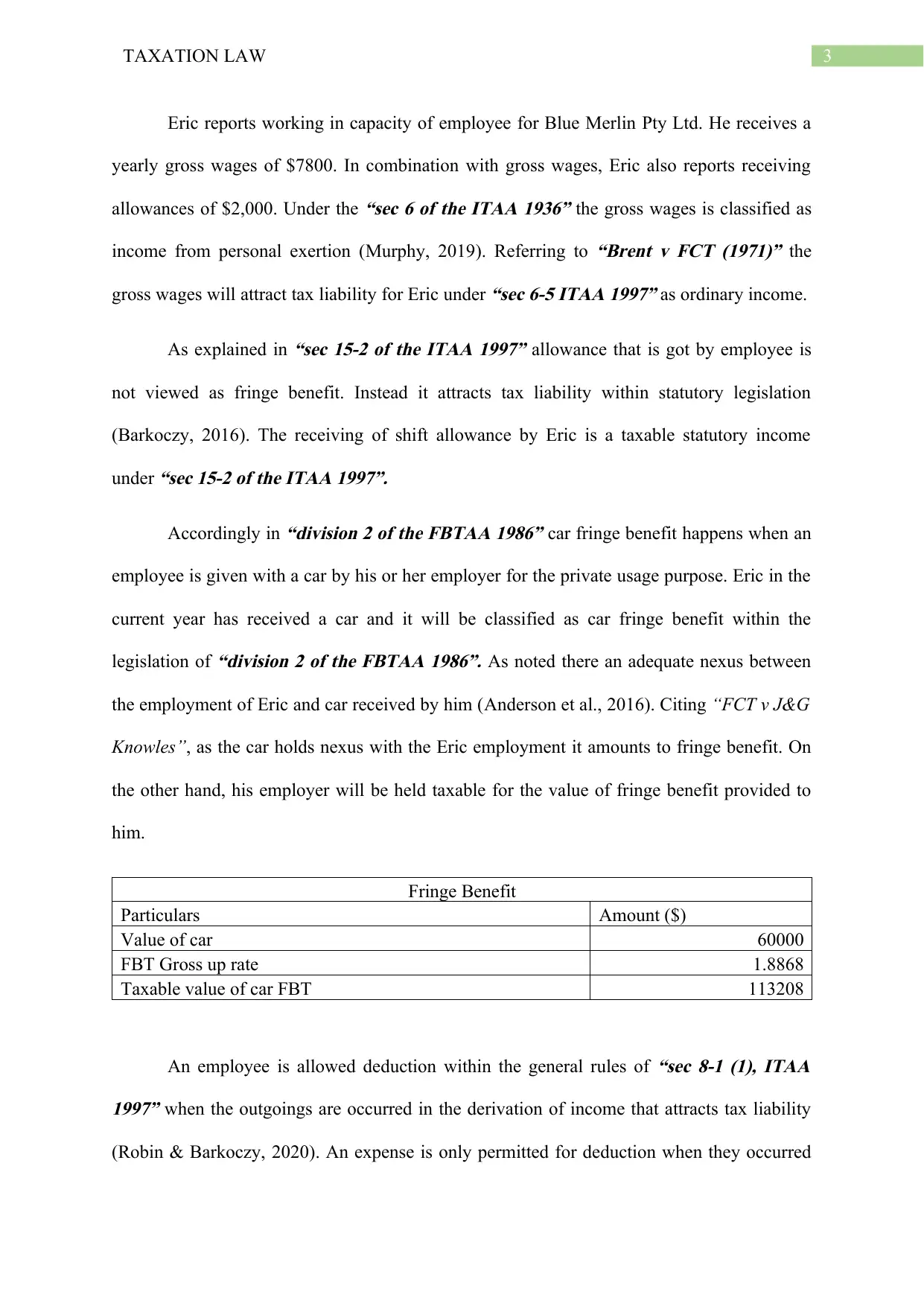
3TAXATION LAW
Eric reports working in capacity of employee for Blue Merlin Pty Ltd. He receives a
yearly gross wages of $7800. In combination with gross wages, Eric also reports receiving
allowances of $2,000. Under the
“sec 6 of the ITAA 1936” the gross wages is classified as
income from personal exertion (Murphy, 2019). Referring to
“Brent v FCT (1971)” the
gross wages will attract tax liability for Eric under
“sec 6-5 ITAA 1997” as ordinary income.
As explained in
“sec 15-2 of the ITAA 1997” allowance that is got by employee is
not viewed as fringe benefit. Instead it attracts tax liability within statutory legislation
(Barkoczy, 2016). The receiving of shift allowance by Eric is a taxable statutory income
under
“sec 15-2 of the ITAA 1997”.
Accordingly in
“division 2 of the FBTAA 1986” car fringe benefit happens when an
employee is given with a car by his or her employer for the private usage purpose. Eric in the
current year has received a car and it will be classified as car fringe benefit within the
legislation of
“division 2 of the FBTAA 1986”. As noted there an adequate nexus between
the employment of Eric and car received by him (Anderson et al., 2016). Citing “FCT v J&G
Knowles”, as the car holds nexus with the Eric employment it amounts to fringe benefit. On
the other hand, his employer will be held taxable for the value of fringe benefit provided to
him.
Fringe Benefit
Particulars Amount ($)
Value of car 60000
FBT Gross up rate 1.8868
Taxable value of car FBT 113208
An employee is allowed deduction within the general rules of
“sec 8-1 (1), ITAA
1997” when the outgoings are occurred in the derivation of income that attracts tax liability
(Robin & Barkoczy, 2020). An expense is only permitted for deduction when they occurred
Eric reports working in capacity of employee for Blue Merlin Pty Ltd. He receives a
yearly gross wages of $7800. In combination with gross wages, Eric also reports receiving
allowances of $2,000. Under the
“sec 6 of the ITAA 1936” the gross wages is classified as
income from personal exertion (Murphy, 2019). Referring to
“Brent v FCT (1971)” the
gross wages will attract tax liability for Eric under
“sec 6-5 ITAA 1997” as ordinary income.
As explained in
“sec 15-2 of the ITAA 1997” allowance that is got by employee is
not viewed as fringe benefit. Instead it attracts tax liability within statutory legislation
(Barkoczy, 2016). The receiving of shift allowance by Eric is a taxable statutory income
under
“sec 15-2 of the ITAA 1997”.
Accordingly in
“division 2 of the FBTAA 1986” car fringe benefit happens when an
employee is given with a car by his or her employer for the private usage purpose. Eric in the
current year has received a car and it will be classified as car fringe benefit within the
legislation of
“division 2 of the FBTAA 1986”. As noted there an adequate nexus between
the employment of Eric and car received by him (Anderson et al., 2016). Citing “FCT v J&G
Knowles”, as the car holds nexus with the Eric employment it amounts to fringe benefit. On
the other hand, his employer will be held taxable for the value of fringe benefit provided to
him.
Fringe Benefit
Particulars Amount ($)
Value of car 60000
FBT Gross up rate 1.8868
Taxable value of car FBT 113208
An employee is allowed deduction within the general rules of
“sec 8-1 (1), ITAA
1997” when the outgoings are occurred in the derivation of income that attracts tax liability
(Robin & Barkoczy, 2020). An expense is only permitted for deduction when they occurred
Paraphrase This Document
Need a fresh take? Get an instant paraphrase of this document with our AI Paraphraser
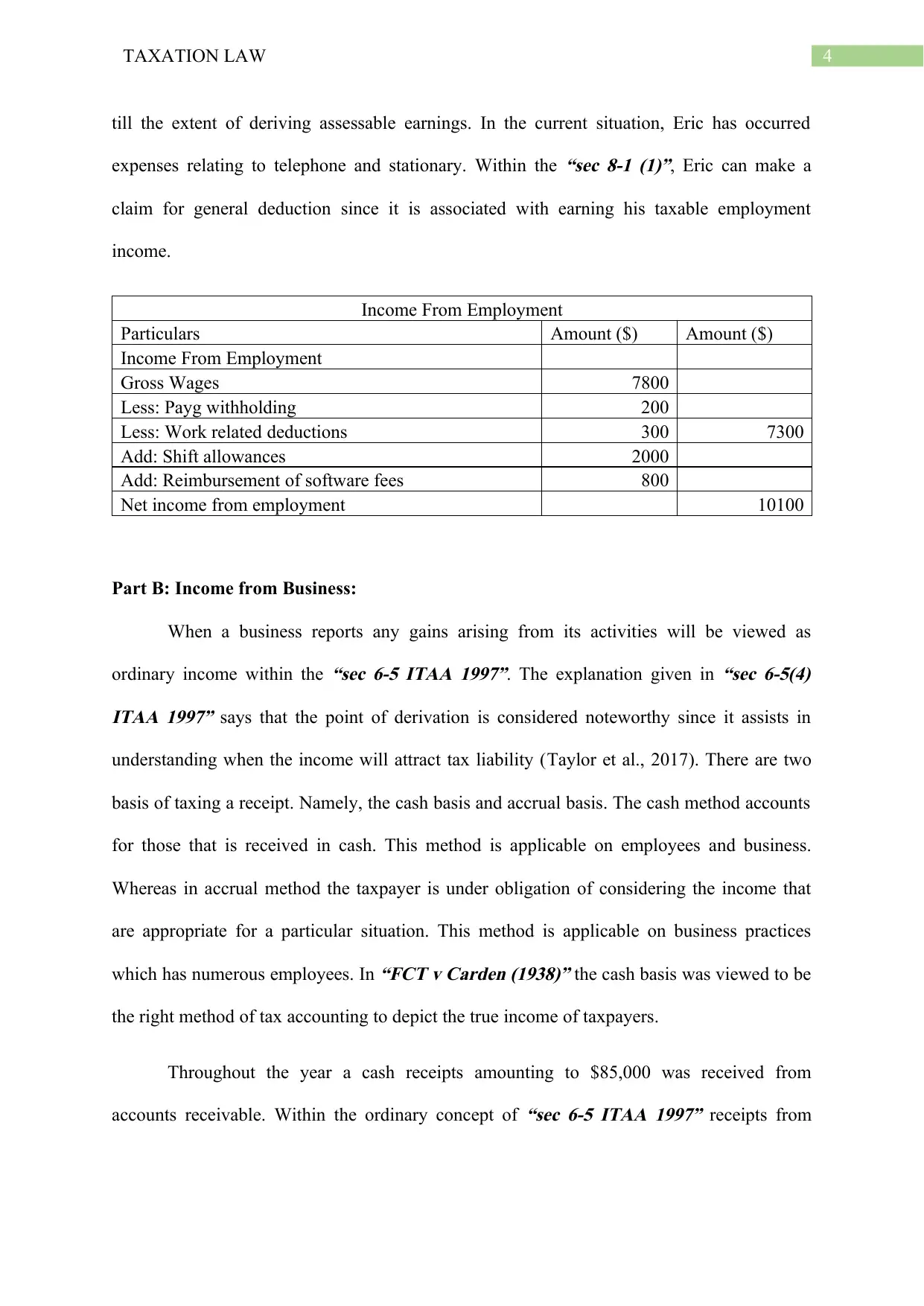
4TAXATION LAW
till the extent of deriving assessable earnings. In the current situation, Eric has occurred
expenses relating to telephone and stationary. Within the
“sec 8-1 (1)”, Eric can make a
claim for general deduction since it is associated with earning his taxable employment
income.
Income From Employment
Particulars Amount ($) Amount ($)
Income From Employment
Gross Wages 7800
Less: Payg withholding 200
Less: Work related deductions 300 7300
Add: Shift allowances 2000
Add: Reimbursement of software fees 800
Net income from employment 10100
Part B: Income from Business:
When a business reports any gains arising from its activities will be viewed as
ordinary income within the
“sec 6-5 ITAA 1997”. The explanation given in
“sec 6-5(4)
ITAA 1997” says that the point of derivation is considered noteworthy since it assists in
understanding when the income will attract tax liability (Taylor et al., 2017). There are two
basis of taxing a receipt. Namely, the cash basis and accrual basis. The cash method accounts
for those that is received in cash. This method is applicable on employees and business.
Whereas in accrual method the taxpayer is under obligation of considering the income that
are appropriate for a particular situation. This method is applicable on business practices
which has numerous employees. In
“FCT v Carden (1938)” the cash basis was viewed to be
the right method of tax accounting to depict the true income of taxpayers.
Throughout the year a cash receipts amounting to $85,000 was received from
accounts receivable. Within the ordinary concept of
“sec 6-5 ITAA 1997” receipts from
till the extent of deriving assessable earnings. In the current situation, Eric has occurred
expenses relating to telephone and stationary. Within the
“sec 8-1 (1)”, Eric can make a
claim for general deduction since it is associated with earning his taxable employment
income.
Income From Employment
Particulars Amount ($) Amount ($)
Income From Employment
Gross Wages 7800
Less: Payg withholding 200
Less: Work related deductions 300 7300
Add: Shift allowances 2000
Add: Reimbursement of software fees 800
Net income from employment 10100
Part B: Income from Business:
When a business reports any gains arising from its activities will be viewed as
ordinary income within the
“sec 6-5 ITAA 1997”. The explanation given in
“sec 6-5(4)
ITAA 1997” says that the point of derivation is considered noteworthy since it assists in
understanding when the income will attract tax liability (Taylor et al., 2017). There are two
basis of taxing a receipt. Namely, the cash basis and accrual basis. The cash method accounts
for those that is received in cash. This method is applicable on employees and business.
Whereas in accrual method the taxpayer is under obligation of considering the income that
are appropriate for a particular situation. This method is applicable on business practices
which has numerous employees. In
“FCT v Carden (1938)” the cash basis was viewed to be
the right method of tax accounting to depict the true income of taxpayers.
Throughout the year a cash receipts amounting to $85,000 was received from
accounts receivable. Within the ordinary concept of
“sec 6-5 ITAA 1997” receipts from
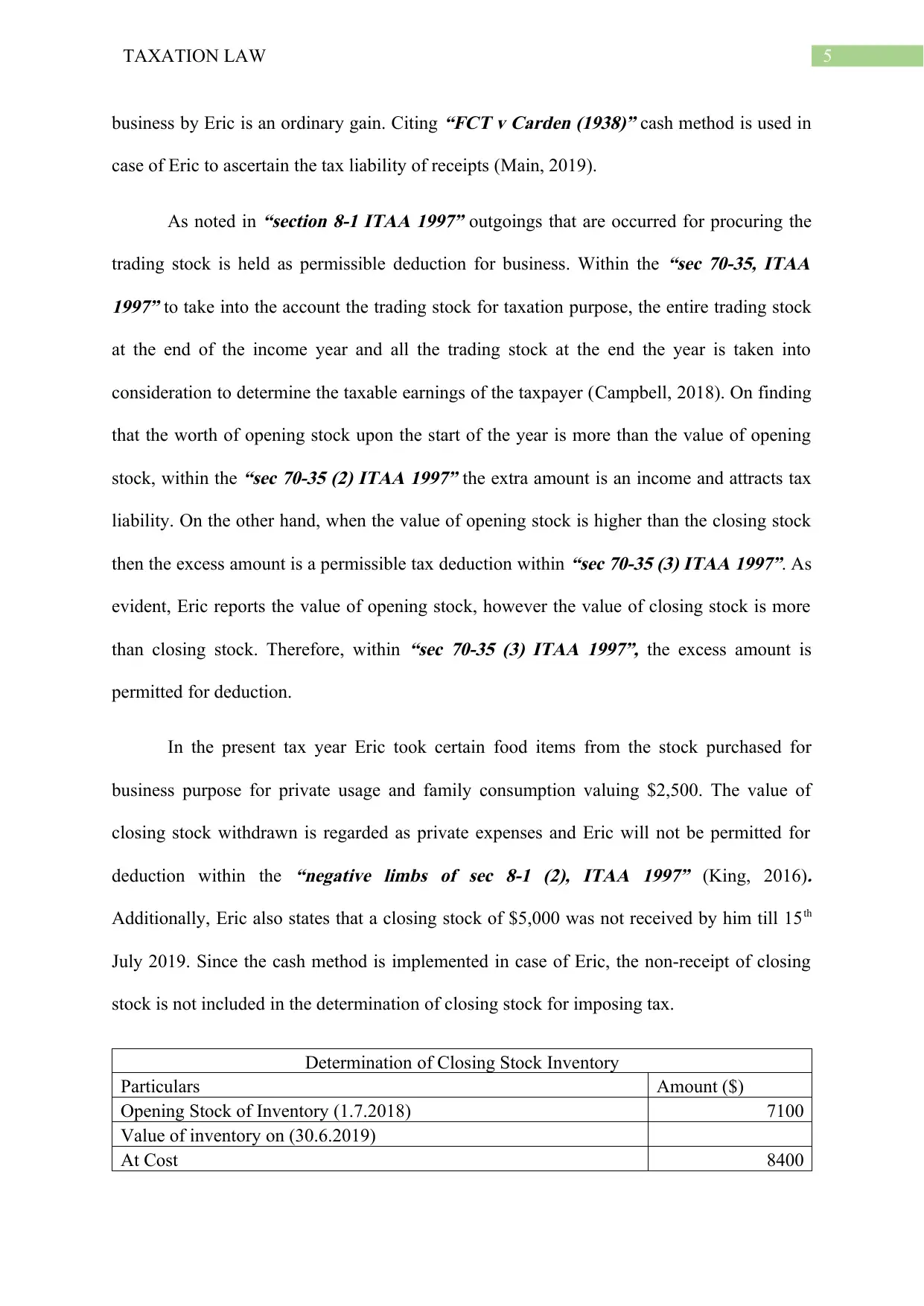
5TAXATION LAW
business by Eric is an ordinary gain. Citing
“FCT v Carden (1938)” cash method is used in
case of Eric to ascertain the tax liability of receipts (Main, 2019).
As noted in
“section 8-1 ITAA 1997” outgoings that are occurred for procuring the
trading stock is held as permissible deduction for business. Within the
“sec 70-35, ITAA
1997” to take into the account the trading stock for taxation purpose, the entire trading stock
at the end of the income year and all the trading stock at the end the year is taken into
consideration to determine the taxable earnings of the taxpayer (Campbell, 2018). On finding
that the worth of opening stock upon the start of the year is more than the value of opening
stock, within the
“sec 70-35 (2) ITAA 1997” the extra amount is an income and attracts tax
liability. On the other hand, when the value of opening stock is higher than the closing stock
then the excess amount is a permissible tax deduction within
“sec 70-35 (3) ITAA 1997”. As
evident, Eric reports the value of opening stock, however the value of closing stock is more
than closing stock. Therefore, within
“sec 70-35 (3) ITAA 1997”, the excess amount is
permitted for deduction.
In the present tax year Eric took certain food items from the stock purchased for
business purpose for private usage and family consumption valuing $2,500. The value of
closing stock withdrawn is regarded as private expenses and Eric will not be permitted for
deduction within the
“negative limbs of sec 8-1 (2), ITAA 1997” (King, 2016)
.
Additionally, Eric also states that a closing stock of $5,000 was not received by him till 15th
July 2019. Since the cash method is implemented in case of Eric, the non-receipt of closing
stock is not included in the determination of closing stock for imposing tax.
Determination of Closing Stock Inventory
Particulars Amount ($)
Opening Stock of Inventory (1.7.2018) 7100
Value of inventory on (30.6.2019)
At Cost 8400
business by Eric is an ordinary gain. Citing
“FCT v Carden (1938)” cash method is used in
case of Eric to ascertain the tax liability of receipts (Main, 2019).
As noted in
“section 8-1 ITAA 1997” outgoings that are occurred for procuring the
trading stock is held as permissible deduction for business. Within the
“sec 70-35, ITAA
1997” to take into the account the trading stock for taxation purpose, the entire trading stock
at the end of the income year and all the trading stock at the end the year is taken into
consideration to determine the taxable earnings of the taxpayer (Campbell, 2018). On finding
that the worth of opening stock upon the start of the year is more than the value of opening
stock, within the
“sec 70-35 (2) ITAA 1997” the extra amount is an income and attracts tax
liability. On the other hand, when the value of opening stock is higher than the closing stock
then the excess amount is a permissible tax deduction within
“sec 70-35 (3) ITAA 1997”. As
evident, Eric reports the value of opening stock, however the value of closing stock is more
than closing stock. Therefore, within
“sec 70-35 (3) ITAA 1997”, the excess amount is
permitted for deduction.
In the present tax year Eric took certain food items from the stock purchased for
business purpose for private usage and family consumption valuing $2,500. The value of
closing stock withdrawn is regarded as private expenses and Eric will not be permitted for
deduction within the
“negative limbs of sec 8-1 (2), ITAA 1997” (King, 2016)
.
Additionally, Eric also states that a closing stock of $5,000 was not received by him till 15th
July 2019. Since the cash method is implemented in case of Eric, the non-receipt of closing
stock is not included in the determination of closing stock for imposing tax.
Determination of Closing Stock Inventory
Particulars Amount ($)
Opening Stock of Inventory (1.7.2018) 7100
Value of inventory on (30.6.2019)
At Cost 8400
⊘ This is a preview!⊘
Do you want full access?
Subscribe today to unlock all pages.

Trusted by 1+ million students worldwide
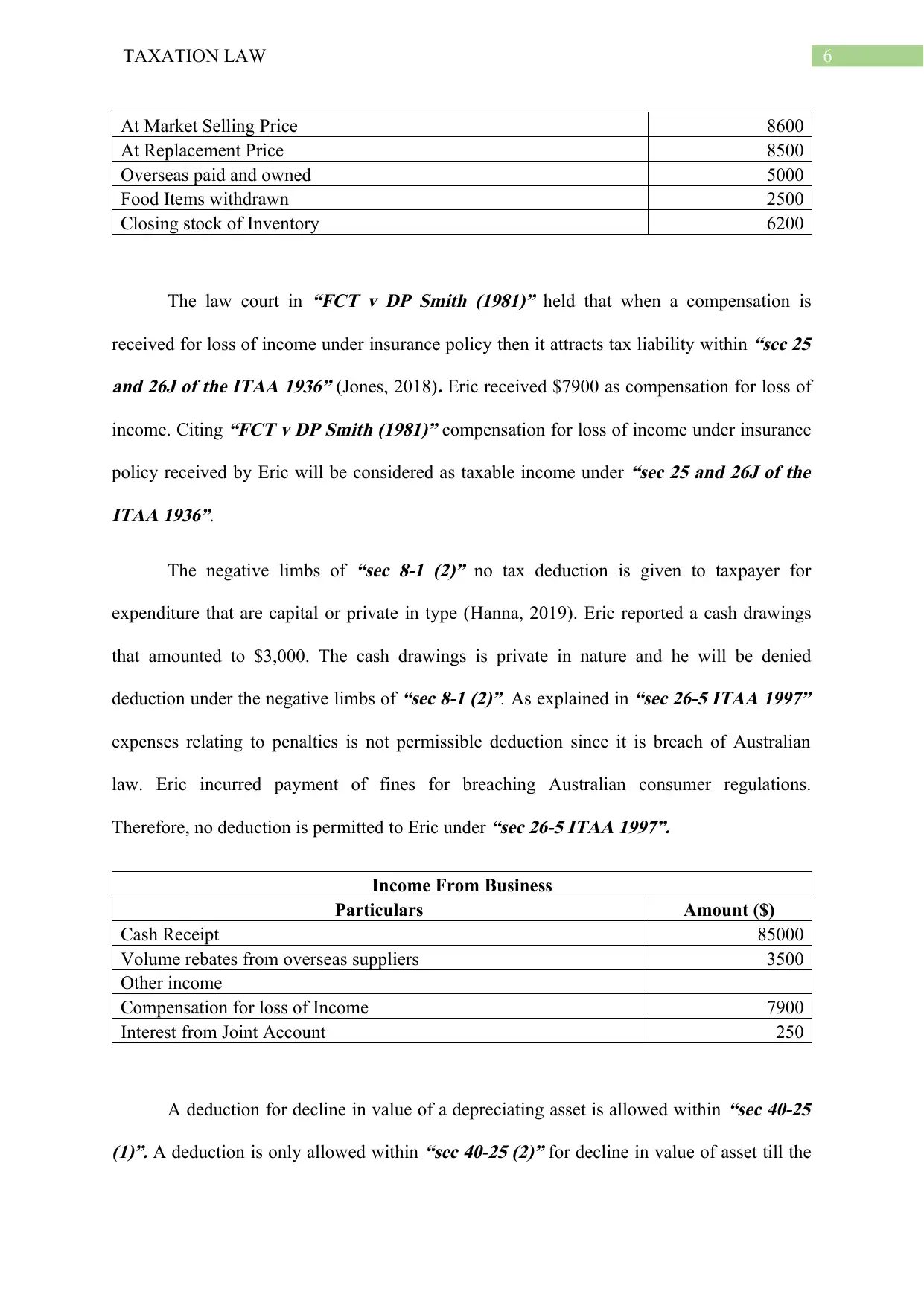
6TAXATION LAW
At Market Selling Price 8600
At Replacement Price 8500
Overseas paid and owned 5000
Food Items withdrawn 2500
Closing stock of Inventory 6200
The law court in
“FCT v DP Smith (1981)” held that when a compensation is
received for loss of income under insurance policy then it attracts tax liability within
“sec 25
and 26J of the ITAA 1936” (Jones, 2018)
. Eric received $7900 as compensation for loss of
income. Citing
“FCT v DP Smith (1981)” compensation for loss of income under insurance
policy received by Eric will be considered as taxable income under
“sec 25 and 26J of the
ITAA 1936”.
The negative limbs of
“sec 8-1 (2)” no tax deduction is given to taxpayer for
expenditure that are capital or private in type (Hanna, 2019). Eric reported a cash drawings
that amounted to $3,000. The cash drawings is private in nature and he will be denied
deduction under the negative limbs of
“sec 8-1 (2)”. As explained in
“sec 26-5 ITAA 1997”
expenses relating to penalties is not permissible deduction since it is breach of Australian
law. Eric incurred payment of fines for breaching Australian consumer regulations.
Therefore, no deduction is permitted to Eric under
“sec 26-5 ITAA 1997”.
Income From Business
Particulars Amount ($)
Cash Receipt 85000
Volume rebates from overseas suppliers 3500
Other income
Compensation for loss of Income 7900
Interest from Joint Account 250
A deduction for decline in value of a depreciating asset is allowed within
“sec 40-25
(1)”. A deduction is only allowed within
“sec 40-25 (2)” for decline in value of asset till the
At Market Selling Price 8600
At Replacement Price 8500
Overseas paid and owned 5000
Food Items withdrawn 2500
Closing stock of Inventory 6200
The law court in
“FCT v DP Smith (1981)” held that when a compensation is
received for loss of income under insurance policy then it attracts tax liability within
“sec 25
and 26J of the ITAA 1936” (Jones, 2018)
. Eric received $7900 as compensation for loss of
income. Citing
“FCT v DP Smith (1981)” compensation for loss of income under insurance
policy received by Eric will be considered as taxable income under
“sec 25 and 26J of the
ITAA 1936”.
The negative limbs of
“sec 8-1 (2)” no tax deduction is given to taxpayer for
expenditure that are capital or private in type (Hanna, 2019). Eric reported a cash drawings
that amounted to $3,000. The cash drawings is private in nature and he will be denied
deduction under the negative limbs of
“sec 8-1 (2)”. As explained in
“sec 26-5 ITAA 1997”
expenses relating to penalties is not permissible deduction since it is breach of Australian
law. Eric incurred payment of fines for breaching Australian consumer regulations.
Therefore, no deduction is permitted to Eric under
“sec 26-5 ITAA 1997”.
Income From Business
Particulars Amount ($)
Cash Receipt 85000
Volume rebates from overseas suppliers 3500
Other income
Compensation for loss of Income 7900
Interest from Joint Account 250
A deduction for decline in value of a depreciating asset is allowed within
“sec 40-25
(1)”. A deduction is only allowed within
“sec 40-25 (2)” for decline in value of asset till the
Paraphrase This Document
Need a fresh take? Get an instant paraphrase of this document with our AI Paraphraser
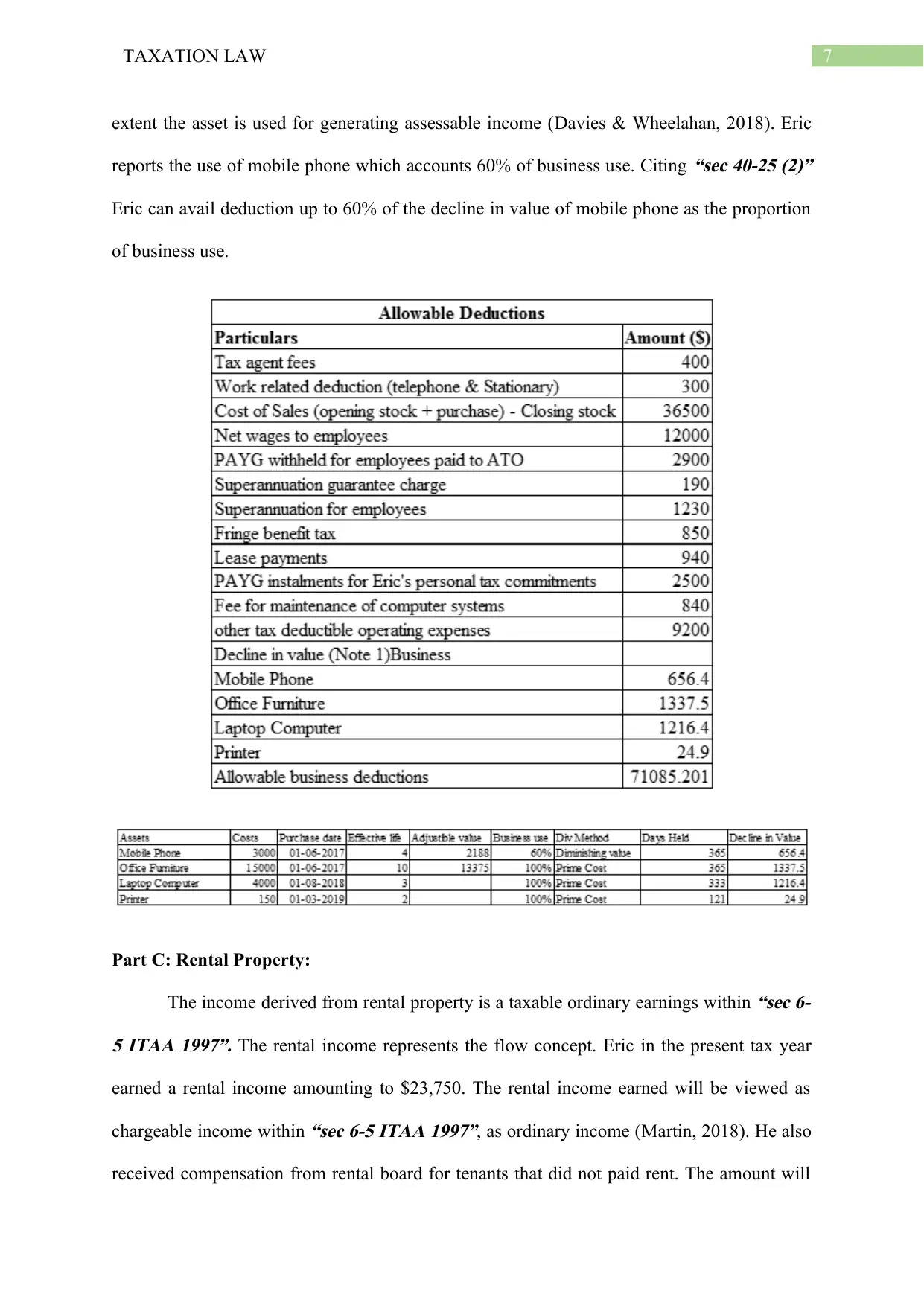
7TAXATION LAW
extent the asset is used for generating assessable income (Davies & Wheelahan, 2018). Eric
reports the use of mobile phone which accounts 60% of business use. Citing
“sec 40-25 (2)”
Eric can avail deduction up to 60% of the decline in value of mobile phone as the proportion
of business use.
Part C: Rental Property:
The income derived from rental property is a taxable ordinary earnings within
“sec 6-
5 ITAA 1997”. The rental income represents the flow concept. Eric in the present tax year
earned a rental income amounting to $23,750. The rental income earned will be viewed as
chargeable income within
“sec 6-5 ITAA 1997”, as ordinary income (Martin, 2018). He also
received compensation from rental board for tenants that did not paid rent. The amount will
extent the asset is used for generating assessable income (Davies & Wheelahan, 2018). Eric
reports the use of mobile phone which accounts 60% of business use. Citing
“sec 40-25 (2)”
Eric can avail deduction up to 60% of the decline in value of mobile phone as the proportion
of business use.
Part C: Rental Property:
The income derived from rental property is a taxable ordinary earnings within
“sec 6-
5 ITAA 1997”. The rental income represents the flow concept. Eric in the present tax year
earned a rental income amounting to $23,750. The rental income earned will be viewed as
chargeable income within
“sec 6-5 ITAA 1997”, as ordinary income (Martin, 2018). He also
received compensation from rental board for tenants that did not paid rent. The amount will
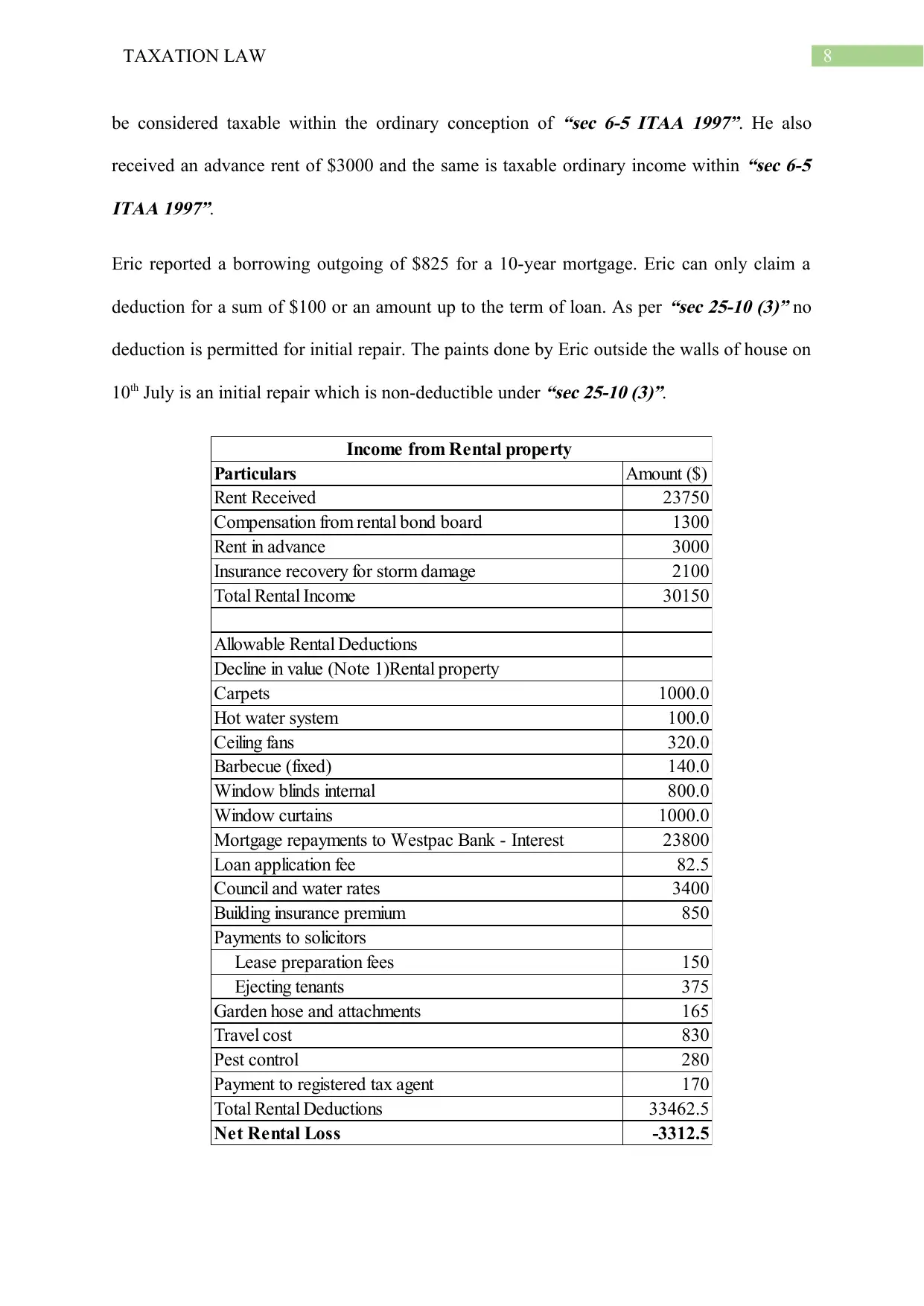
8TAXATION LAW
be considered taxable within the ordinary conception of
“sec 6-5 ITAA 1997”. He also
received an advance rent of $3000 and the same is taxable ordinary income within
“sec 6-5
ITAA 1997”.
Eric reported a borrowing outgoing of $825 for a 10-year mortgage. Eric can only claim a
deduction for a sum of $100 or an amount up to the term of loan. As per
“sec 25-10 (3)” no
deduction is permitted for initial repair. The paints done by Eric outside the walls of house on
10th July is an initial repair which is non-deductible under
“sec 25-10 (3)”.
Particulars Amount ($)
Rent Received 23750
Compensation from rental bond board 1300
Rent in advance 3000
Insurance recovery for storm damage 2100
Total Rental Income 30150
Allowable Rental Deductions
Decline in value (Note 1)Rental property
Carpets 1000.0
Hot water system 100.0
Ceiling fans 320.0
Barbecue (fixed) 140.0
Window blinds internal 800.0
Window curtains 1000.0
Mortgage repayments to Westpac Bank - Interest 23800
Loan application fee 82.5
Council and water rates 3400
Building insurance premium 850
Payments to solicitors
Lease preparation fees 150
Ejecting tenants 375
Garden hose and attachments 165
Travel cost 830
Pest control 280
Payment to registered tax agent 170
Total Rental Deductions 33462.5
Net Rental Loss -3312.5
Income from Rental property
be considered taxable within the ordinary conception of
“sec 6-5 ITAA 1997”. He also
received an advance rent of $3000 and the same is taxable ordinary income within
“sec 6-5
ITAA 1997”.
Eric reported a borrowing outgoing of $825 for a 10-year mortgage. Eric can only claim a
deduction for a sum of $100 or an amount up to the term of loan. As per
“sec 25-10 (3)” no
deduction is permitted for initial repair. The paints done by Eric outside the walls of house on
10th July is an initial repair which is non-deductible under
“sec 25-10 (3)”.
Particulars Amount ($)
Rent Received 23750
Compensation from rental bond board 1300
Rent in advance 3000
Insurance recovery for storm damage 2100
Total Rental Income 30150
Allowable Rental Deductions
Decline in value (Note 1)Rental property
Carpets 1000.0
Hot water system 100.0
Ceiling fans 320.0
Barbecue (fixed) 140.0
Window blinds internal 800.0
Window curtains 1000.0
Mortgage repayments to Westpac Bank - Interest 23800
Loan application fee 82.5
Council and water rates 3400
Building insurance premium 850
Payments to solicitors
Lease preparation fees 150
Ejecting tenants 375
Garden hose and attachments 165
Travel cost 830
Pest control 280
Payment to registered tax agent 170
Total Rental Deductions 33462.5
Net Rental Loss -3312.5
Income from Rental property
⊘ This is a preview!⊘
Do you want full access?
Subscribe today to unlock all pages.

Trusted by 1+ million students worldwide
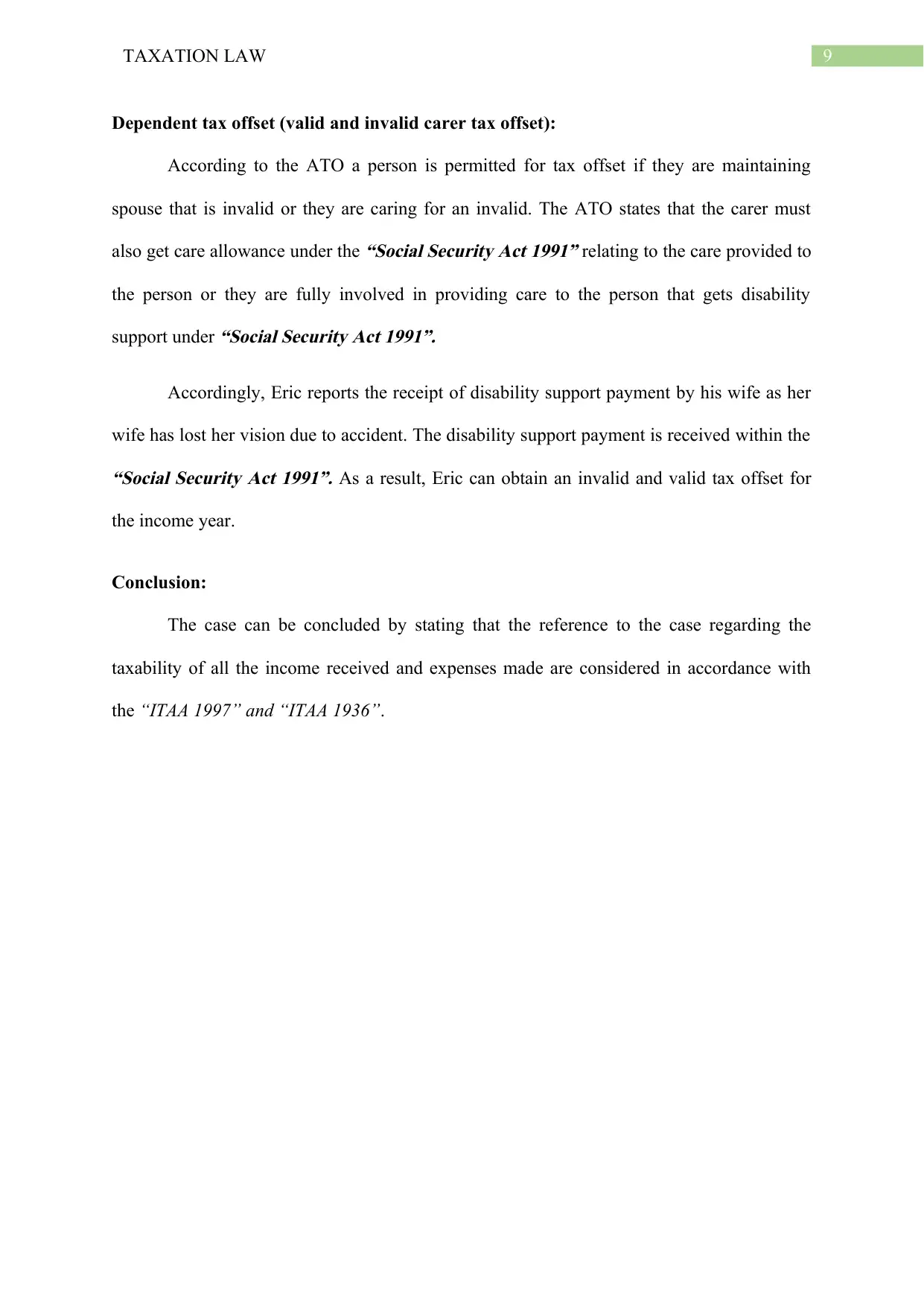
9TAXATION LAW
Dependent tax offset (valid and invalid carer tax offset):
According to the ATO a person is permitted for tax offset if they are maintaining
spouse that is invalid or they are caring for an invalid. The ATO states that the carer must
also get care allowance under the
“Social Security Act 1991” relating to the care provided to
the person or they are fully involved in providing care to the person that gets disability
support under
“Social Security Act 1991”.
Accordingly, Eric reports the receipt of disability support payment by his wife as her
wife has lost her vision due to accident. The disability support payment is received within the
“Social Security Act 1991”. As a result, Eric can obtain an invalid and valid tax offset for
the income year.
Conclusion:
The case can be concluded by stating that the reference to the case regarding the
taxability of all the income received and expenses made are considered in accordance with
the “ITAA 1997” and “ITAA 1936”.
Dependent tax offset (valid and invalid carer tax offset):
According to the ATO a person is permitted for tax offset if they are maintaining
spouse that is invalid or they are caring for an invalid. The ATO states that the carer must
also get care allowance under the
“Social Security Act 1991” relating to the care provided to
the person or they are fully involved in providing care to the person that gets disability
support under
“Social Security Act 1991”.
Accordingly, Eric reports the receipt of disability support payment by his wife as her
wife has lost her vision due to accident. The disability support payment is received within the
“Social Security Act 1991”. As a result, Eric can obtain an invalid and valid tax offset for
the income year.
Conclusion:
The case can be concluded by stating that the reference to the case regarding the
taxability of all the income received and expenses made are considered in accordance with
the “ITAA 1997” and “ITAA 1936”.
Paraphrase This Document
Need a fresh take? Get an instant paraphrase of this document with our AI Paraphraser
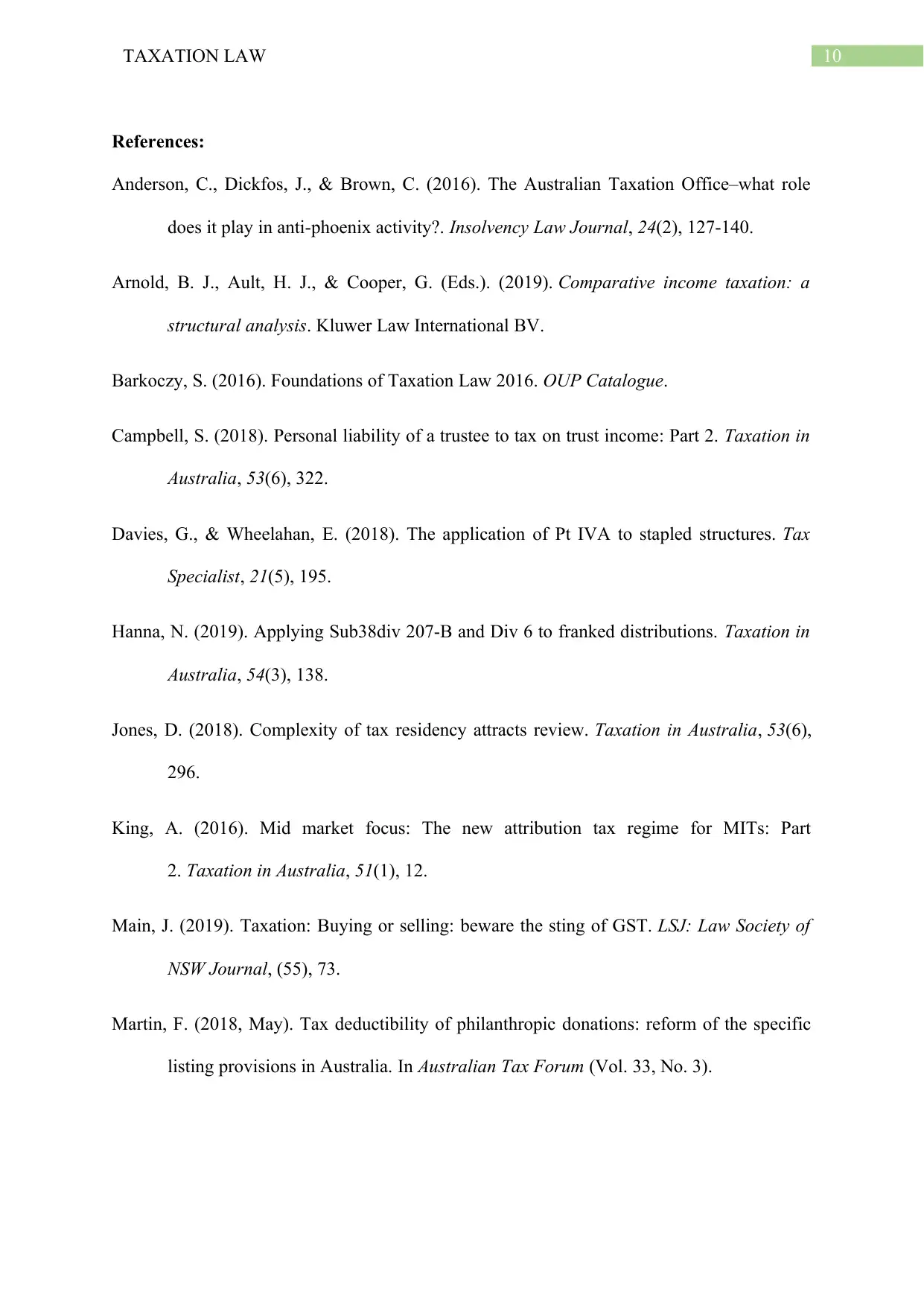
10TAXATION LAW
References:
Anderson, C., Dickfos, J., & Brown, C. (2016). The Australian Taxation Office–what role
does it play in anti-phoenix activity?. Insolvency Law Journal, 24(2), 127-140.
Arnold, B. J., Ault, H. J., & Cooper, G. (Eds.). (2019). Comparative income taxation: a
structural analysis. Kluwer Law International BV.
Barkoczy, S. (2016). Foundations of Taxation Law 2016. OUP Catalogue.
Campbell, S. (2018). Personal liability of a trustee to tax on trust income: Part 2. Taxation in
Australia, 53(6), 322.
Davies, G., & Wheelahan, E. (2018). The application of Pt IVA to stapled structures. Tax
Specialist, 21(5), 195.
Hanna, N. (2019). Applying Sub38div 207-B and Div 6 to franked distributions. Taxation in
Australia, 54(3), 138.
Jones, D. (2018). Complexity of tax residency attracts review. Taxation in Australia, 53(6),
296.
King, A. (2016). Mid market focus: The new attribution tax regime for MITs: Part
2. Taxation in Australia, 51(1), 12.
Main, J. (2019). Taxation: Buying or selling: beware the sting of GST. LSJ: Law Society of
NSW Journal, (55), 73.
Martin, F. (2018, May). Tax deductibility of philanthropic donations: reform of the specific
listing provisions in Australia. In Australian Tax Forum (Vol. 33, No. 3).
References:
Anderson, C., Dickfos, J., & Brown, C. (2016). The Australian Taxation Office–what role
does it play in anti-phoenix activity?. Insolvency Law Journal, 24(2), 127-140.
Arnold, B. J., Ault, H. J., & Cooper, G. (Eds.). (2019). Comparative income taxation: a
structural analysis. Kluwer Law International BV.
Barkoczy, S. (2016). Foundations of Taxation Law 2016. OUP Catalogue.
Campbell, S. (2018). Personal liability of a trustee to tax on trust income: Part 2. Taxation in
Australia, 53(6), 322.
Davies, G., & Wheelahan, E. (2018). The application of Pt IVA to stapled structures. Tax
Specialist, 21(5), 195.
Hanna, N. (2019). Applying Sub38div 207-B and Div 6 to franked distributions. Taxation in
Australia, 54(3), 138.
Jones, D. (2018). Complexity of tax residency attracts review. Taxation in Australia, 53(6),
296.
King, A. (2016). Mid market focus: The new attribution tax regime for MITs: Part
2. Taxation in Australia, 51(1), 12.
Main, J. (2019). Taxation: Buying or selling: beware the sting of GST. LSJ: Law Society of
NSW Journal, (55), 73.
Martin, F. (2018, May). Tax deductibility of philanthropic donations: reform of the specific
listing provisions in Australia. In Australian Tax Forum (Vol. 33, No. 3).
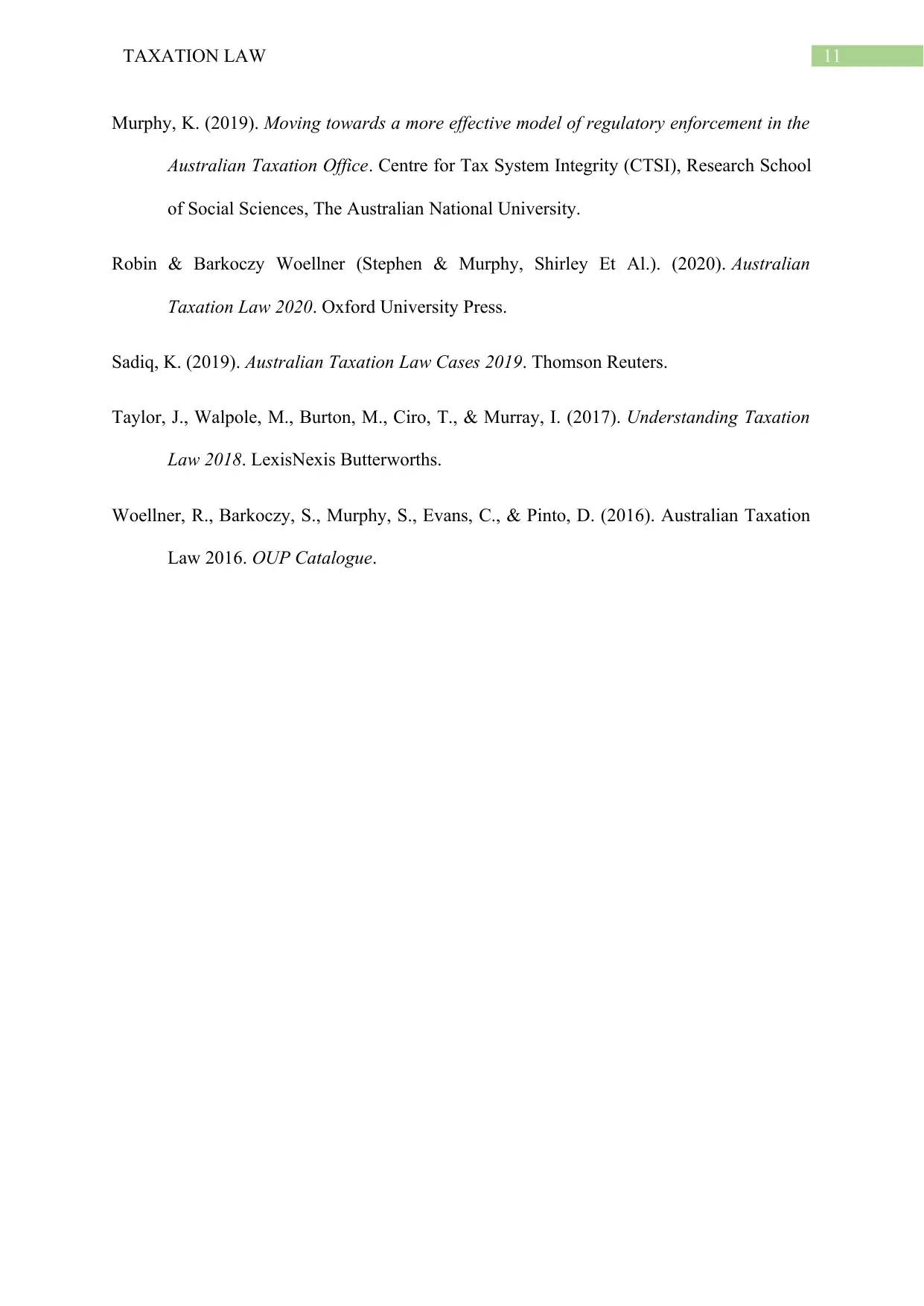
11TAXATION LAW
Murphy, K. (2019). Moving towards a more effective model of regulatory enforcement in the
Australian Taxation Office. Centre for Tax System Integrity (CTSI), Research School
of Social Sciences, The Australian National University.
Robin & Barkoczy Woellner (Stephen & Murphy, Shirley Et Al.). (2020). Australian
Taxation Law 2020. Oxford University Press.
Sadiq, K. (2019). Australian Taxation Law Cases 2019. Thomson Reuters.
Taylor, J., Walpole, M., Burton, M., Ciro, T., & Murray, I. (2017). Understanding Taxation
Law 2018. LexisNexis Butterworths.
Woellner, R., Barkoczy, S., Murphy, S., Evans, C., & Pinto, D. (2016). Australian Taxation
Law 2016. OUP Catalogue.
Murphy, K. (2019). Moving towards a more effective model of regulatory enforcement in the
Australian Taxation Office. Centre for Tax System Integrity (CTSI), Research School
of Social Sciences, The Australian National University.
Robin & Barkoczy Woellner (Stephen & Murphy, Shirley Et Al.). (2020). Australian
Taxation Law 2020. Oxford University Press.
Sadiq, K. (2019). Australian Taxation Law Cases 2019. Thomson Reuters.
Taylor, J., Walpole, M., Burton, M., Ciro, T., & Murray, I. (2017). Understanding Taxation
Law 2018. LexisNexis Butterworths.
Woellner, R., Barkoczy, S., Murphy, S., Evans, C., & Pinto, D. (2016). Australian Taxation
Law 2016. OUP Catalogue.
⊘ This is a preview!⊘
Do you want full access?
Subscribe today to unlock all pages.

Trusted by 1+ million students worldwide
1 out of 12
Related Documents
Your All-in-One AI-Powered Toolkit for Academic Success.
+13062052269
info@desklib.com
Available 24*7 on WhatsApp / Email
![[object Object]](/_next/static/media/star-bottom.7253800d.svg)
Unlock your academic potential
Copyright © 2020–2025 A2Z Services. All Rights Reserved. Developed and managed by ZUCOL.





